Archive for ‘Books and Reading’ Category
12 Ways to Organize Your Life to Read More — Part 1 (When, Where, What, With Whom)
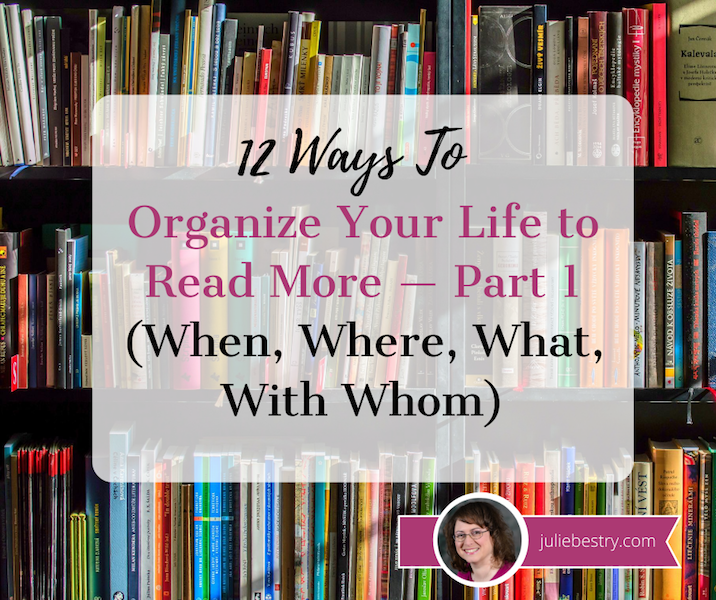
Read any good books lately?
- Does the longest book you’ve read lately end with “Goodnight stars. Goodnight air. Goodnight noises everywhere?”
- Are you being mocked mercilessly by a pile of unread books on your bedside table?
- Maybe you’d like to read that popular novel before it becomes an HBO series?
Paper Doll gets it. Even for the heartiest of readers, there are seasons of life, and in some of those seasons, we aren’t reading. Sometimes, parenthood, work, or a chaotic life gets in the way. Sometimes, there’s a global pandemic giving us all the time to read we could ever want, but we just lack the motivation. (Hey, at least we’re not Burgess Meredith in the saddest episode ever of the Twilight Zone!)
We’ve covered organizing for reading time before, in 12 Tips for Organizing Your Reading Time and Organizing Your Reading Space for More Reading Time. But the world seems like it’s changed quite a bit since 2014, and it’s time to look at some new ways to make your life more reading-friendly.
10 WAYS TO ORGANIZE YOUR LIFE TO READ MORE
1) Gather your TBR collection.
TBR, or “to be read,” may have been a popular acronym previously, but I only learned of it when I started reading the Modern Mrs. Darcy blog. Early on in the quarantine, I had a surprise UPS delivery. My best friend had sent me a bookshelf from my favorite line, Origami Rack. The one she sent me is currently unavailable, but it looks like this…except mine is filled with books, with a corner of the top shelf given over to colorful Post-It® stacks and USB drives.
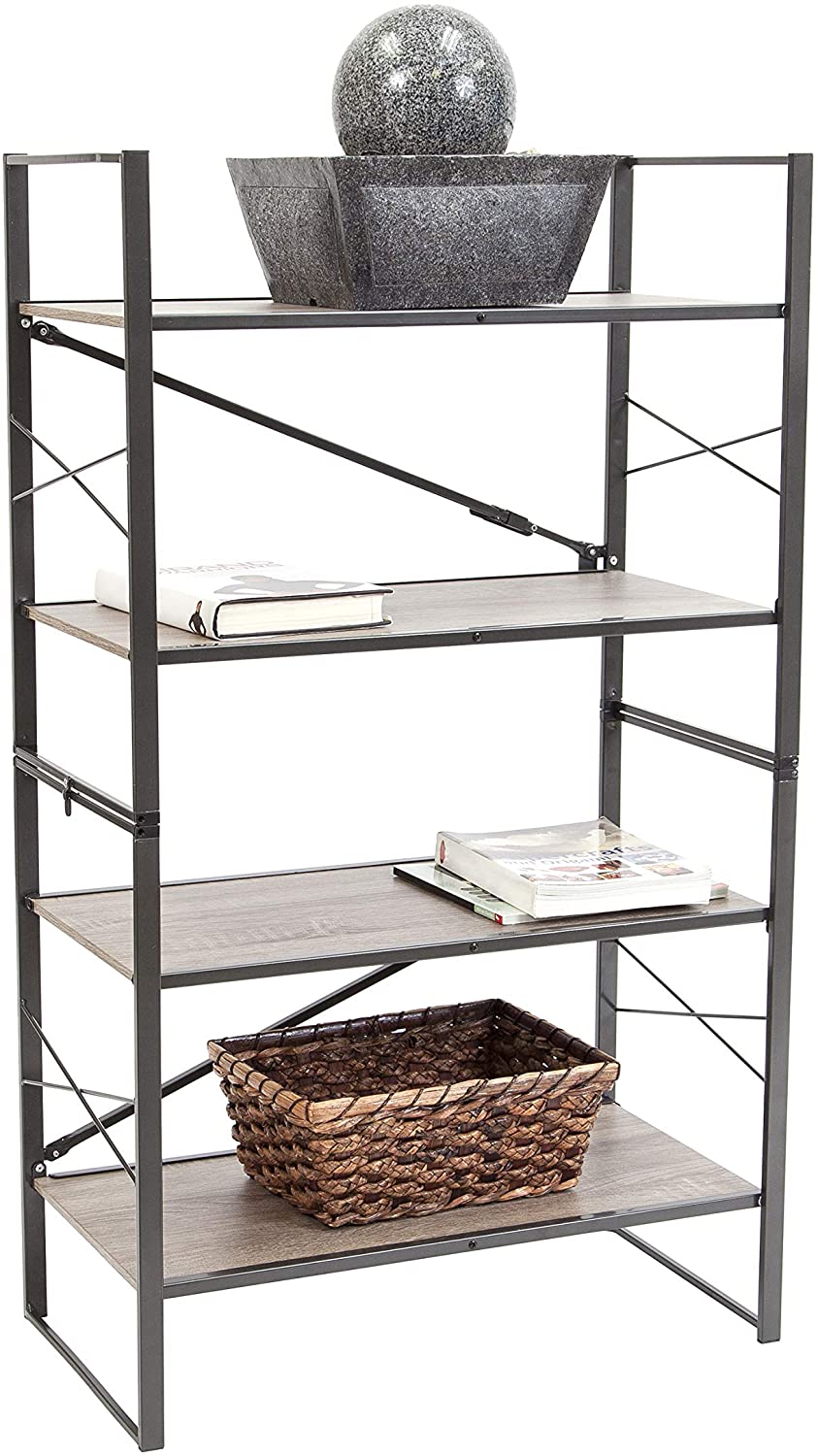
I was so delighted by the bookshelf, I rearranged my office space so that the bookshelf was to my right (appearing prominently in the hundreds of Zoom meetings I was about to have, dramatically improving the aesthetics of my space). I then went through every nook and cranny of my home, collecting every book I had not yet read, and I was shocked at how many unread titles I found:
- 8 novels
- 7 books about reading books
- 6 books about freelance writing
- 9 books about Jane Austen
- 5 books about diabetes
- 4 books about organizing and productivity
- 3 business books, 2 books about the history of Cornell University, and Lin-Manuel Miranda’s GMorning, Gnight! Little Pep Talks for Me and You, which doesn’t really fit any category.
Honestly, I knew I had quite a few unread books, but anticipated they might all fit on one shelf. Having them all in one place, and arranging them by category, made it easier to pick something when the inspiration struck. There are only two novels left, and I’m working my way through the other titles.
Your TBR shelf may just be half a shelf, or your bedside table, or a small square of counterspace. But bringing all of your to-be-read titles together gives you a starting point.

2) Schedule your reading time.
Early during the pandemic, Mike Vardy, The Productivityist, made a short video detailing how to create a good morning routine. When he talked about having 30 minutes of reading time during and after breakfast, it caught my attention.
I have natural points in my day when I might gravitate toward pulling a book off the shelf, usually at the end of the afternoon when I’ve finished my work but am not ready for dinner. Other people naturally read before bed or on their commutes (whether traditional reading on public transportation or listening to audiobooks while driving or riding). These tend to be defaults, times when they’re unlikely to do anything else.
But Mike, like many successful readers, has a firmly-set block in his schedule. He gets up, has breakfast, and reads before any of the chaos of the day can seep in and derail him. He reads before he’s checked email, or made phone calls.
If you’re afraid you’ll get too involved in your book and miss appointments or obligations, set an alarm on your computer, phone, or watch. See if a friend or colleague would like to read at the same time! You could arrange a five-minute phone or text conversation to connect after your reading block to talk about what you’ve read. You’re far less likely to tell yourself “one more chapter…” if you know someone is waiting.
Scheduling a reading block each day doesn’t eliminate the serendipity of coming across some quiet moments where you can hug a book to your chest and get lost in a story. It just means you’re guaranteed some time in your day and space in your schedule for delighting in the written word.
3) Create physical space for reading.
Carving out time for reading is only part of the story. Do you have a place to read? I mean, in theory, you can read anywhere except the shower. I’ve been known to hold my hair dryer in one hand an a good book in another, and I have friends who read in the kitchen while they stir. (Important PSA: Don’t chop and read!)
For some of us, any chair, bed, or square of floorspace will do. If you love to read but avoid reading, you may need a reading nook that’s more conducive to your physical needs. A comfy chair situated outside of the traffic patterns of your house, natural light (or a good reading lamp), a cozy blanket, a small table to hold your phone, beverage, and glasses – doesn’t the idea of this space feel compelling?
Consider employing a currently-unused space for your reading nook, like the corner of your guest room or some open space at the top of your stairs. Basically, if there’s an area in your home that doesn’t require you to move things around to vacuum, that’s a potential reading nook.
4) Replace a habit with reading.
Nancy Haworth, a friend and colleague in my mastermind group (a small group for accountability) shared the following as one of her monthly goals: “Focus on reading books more, rather than getting sucked into social media and news online.”
For the past two months, she’s been reporting what she’s read and how much progress she’s made, both on avoiding the dumpster fire that is the world these days (both in the news and on social media) and on specific books.
This approach would be tough for me. During each transition between activities, from email to writing, or from phone calls to deep work, I instinctively click on news sites to get that dopamine hit. But a recent weekend, during which my schedule was unusually devoid of obligations, I read a 468-page book, and I accomplished it in large part because I avoided turning to news sites and social media.
Are there other habits you’d like to break, or at least bend? If you tend to snack in the mid-afternoon, could moving to your reading nook instead of the kitchen help you accomplish that? If you’ve been working from home instead of the office, chances are that you spend more time sitting at your desk – there’s no cake in the break room or conversations over coffee with colleagues, and there’s no rush to leave work to deal with a commute. If you’re giving the office a little too much of yourself, a few 15-minute reading breaks could be just what you need.
5) Read with others.
Usually, the solitary experience of reading is a comfort. When you read (or reread) a favorite novel, it sometimes seems like you’ve become a quiet (and pleasantly ignored) minor character with a front-row seat to the goings-on. But other books, particularly non-fiction titles focused on topics like business, psychology, history, or current events, create an environment where you want other voices in the room, other people to help you debate whether the author is right, or tease out the true meaning of a paragraph.
Partner with a friend or colleague. It’s like the tiniest possible book club, but arranging with a friend to read a book means you always have something fresh to talk about. You don’t even have to read the same book.
Remember when Rachel and Joey traded recommendations? She read The Shining and he read Little Women?
(Joey’s guidance about putting too-scary books in the freezer isn’t the worst reading advice I’ve heard!) Once, my friend Mark and I simultaneously read one another’s recommendations. I read Great Expectations (meh) and he read Pride & Prejudice (and developed a teeny crush on Mr. Darcy).
Join a book club. Sure, 2020 doesn’t lend itself to attending the typical wine-and-cheese or coffee-and-cake in-person book clubs, but (hopefully) 2020 won’t last forever. Until then, there are all sorts of online book clubs. Book Riot’s How To Join a Book Club Online in 2020 is a good start if you want to share a reading experience with a large group of people reading the same thing, and Time Magazine covered 10 Virtual Book Clubs You Can Join Now.
Or start your own book club. The advantage of starting your own club is that you can set the rules – anything from “No novels by Ernest Hemingway!” to “Only books by left-handed authors!” – and invite like-minded friends. One person can take a professorial lead, members can take turns presenting, or discussion can be a free-for-all.
Friend of the blog Erin Doland, author of Never Too Busy to Cure Clutter and formerly of the Unclutterer blog, recently gathered a gaggle of friends for a virtual non-fiction book club, with discussion in a private Facebook group. The first title was The Inconvenient Indian: A Curious Account of Native People in North America by Thomas King.
Once the world can be social again, NPR’s Life Kit has a great post on How To Start a Book Club That Actually Meets.
6) Be part of a cultural experience.
Sometimes, a book club is a bit too much of a commitment. Maybe you’re an introvert. Or perhaps you’re just not that interested in what others have to say about a reading experience that feels so personal. You can still be part of something larger than yourself.
Have you ever had a book that you just couldn’t tackle, no matter how hard (or how many times) you tried? I’ve given Anna Karenina my best efforts, from my teen years to now in my (muffled static obscuring actual age) years. For (many others) it’s Moby Dick. For them, there’s an audio experience called the Moby Dick Big Read.
The Great American Novel may be great, but it can be daunting. In 2011, a group of artists, writers, musicians, scientists and academics came together for a symposium, sharing their fascination with whales, and it turned into a big fish tale! In other words, you can listen (via Soundcloud, Spotify, Apple Podcasts, or your favorite podcast app) to the 135 chapters (plus the epilogue), told by Tilda Swinson, Stephen Fry, Benedict Cumberbatch, and many others. If this book has been your own white whale and this finally helps you finish it, you can thank me later. Just don’t call me Ishmael.
The National Endowment for the Arts has its own Big Read, an initiative for exposing readers to new genres and ideas and challenges their current tastes in literature. The NEA Big Read sponsors 84 community reading programs, each designed around a single NEA Big Read selection. If your community or library system isn’t participating, you can still pick one of the 25 books in the NEA online library and avail yourself of the discussion questions and multi-media resources.
One City One Book and similarly named “community reads” projects have been operating for more than two decades, with libraries and civic groups encouraging all the people of one community to read the same book. Check your public library system’s website to see what community reading experiences are available to encourage you to read more.
Next time, in part 2, we’ll look at more ways to organize your life for more reading opportunities:
- How to get book recommendations so you can be enthusiastic about reading
- Why (and how) to change reading formats
- The secret to remembering what you’ve read (and liked)
- How to drive your reading mojo with challenges
- The type of book to rev your reading engine
- …and how to develop an appetite for books to better yourself.
Paper Doll’s Ultimate Guide to Organizing a Virtual Field Trip
 Do you remember the field trips you went on as a kid? Even if the trip was headed somewhere you’d been before, or someplace that wasn’t that exciting, there was something compelling about having to turn in that golden ticket of a permission slip, having a shortened class schedule, getting on a bus, perhaps having to hold hands or hold onto a rope, and getting shushed by the teacher in a brand-new environment.
Do you remember the field trips you went on as a kid? Even if the trip was headed somewhere you’d been before, or someplace that wasn’t that exciting, there was something compelling about having to turn in that golden ticket of a permission slip, having a shortened class schedule, getting on a bus, perhaps having to hold hands or hold onto a rope, and getting shushed by the teacher in a brand-new environment.
Growing up in Buffalo, I visited Tifft Farm Nature Preserve and learned how maple syrup was tapped, how maple sugar candy was made, and never to drink a beverage if your field trip is anywhere with outhouses instead of bathrooms!
As a kindergartner, I visited the Mirrored Room at the Albright-Knox Art Gallery, and was transfixed by the mirrored walls, ceiling, and furniture, although the mirrored floor terrified me. Would I fall through into another world?
Throughout elementary school, I got to visit the planetarium built right into one of the district’s newest high schools (giving me an unrealistic expectation of high school fun). And on multiple visits to the Buffalo Museum of Science, I was shocked to come face-to-face with a wooly mammoth.
Yes, my sandwich was always soggy by lunchtime, and my feet were usually tired by the time the bus returned to school, but the whole experience gave kids a burst of energy during long stretches of weeks without holidays.
Couldn’t you use a field trip right about now?
Every day, another thousand blogs tell you how to effectively work from home, entertain and education your children, and be productive on a myriad list of home projects, all during the uncertainties of sheltering in place. And certainly, Paper Doll has thoughts on all of those things. But that’s not what today’s post is about. Because you need a break. (OK, I need a break. Even professional organizers lose their motivation in these wooly mammoth times.)
While you may not be able to take a drive downtown or hop on a subway, you can still ease your mind and stir your soul. You may not be able to pop out to the library, but you can borrow ebooks from your public library. You may not be able to attend a workshop, but there are TedTalks galore. But there’s nothing like the energy of going on a field trip…so off we go!
ORGANIZE FOR A VIRTUAL FIELD TRIP
It’s far too easy to click on some links, making your experiences every bit as quotidian as clicking over to Instagram or going down a rabbit hole of YouTube videos. To make your field trip a mental, emotional, and visceral experience that feels like an adventure, follow these steps.
1) Make a production out of it. Get dressed up. Go outside, walk around the driveway, and come back in with fresh eyes. If your kids don’t have a lot of experience with museums, you can talk about how (when we go on real field trips), we don’t run, how we talk in hushed tones, and how we don’t push people, but we will be rewarded with magical experiences in huge rooms and bright colors and cool sites.
No tiny humans? You and your partner could dress in your fanciest clothes (or, y’know, not the same sweats you’ve been wearing all week) and agree to make the trip as vivid and special as possible. No stopping to check Twitter, no doing laundry.
On your own? Make it less of a solo excursion by sharing the experience with friends. Post a photo collage of yourself, your lunch (of which, more later), and the home screen of your visit’s location. “I’m going to the Louvre today. Ask Me Anything!” Periodically, post something surprising that you’ve learned. Even if you’re alone, you don’t have to be lonely on your field trip.
Even if you're alone, you don't have to be lonely on your field trip. Share on XMake time for your trip. Don’t just sandwich a quick whirl through the web between working on your sourdough starter and bingeing the next episode of Kitten Prince. (OK, I know, but I’m not giving that show any more press!)
Build it into the homeschool day, or schedule it for after dinner on a work-from-home Zoom-filled workday. Experiences are far more memorable than tangible things, which is why they make better gifts than things that turn into clutter. Give yourself a gift of the field trip experience.
Pack a lunch. Remember the brown paper sack lunches for field trips? Paper Mommy was always a room mother, helping corral the kids, but she tucked a note and a little doodled self-portrait into my lunch, folded in with my napkin, nonetheless. Perhaps you could tuck a little quiz or puzzle into a bagged lunch for your kids (or partner, or housemate)?

Or do the museum café thing and try to make a fancy coffee. Break out some wine and quarantine cheese, and make a night of it. When I toured the UK last September, we had gorgeous weather in Scotland, Wales, and most of England, but our only full day in London was dark and rainy all morning, and plagued with kerfuffles. Once we got to the British Museum, we were feeling a bit overwhelmed; there was too much to see in the few hours we had, and we were damp and cranky. After an hour of trying to hit the guidebook highlights (including the actual Rosetta Stone!), we stopped at one of the pop-up cafés on an upper floor, and surrounded by art, had little cakes and beverages, which refreshed our bodies and gave us verve.
You’ve been locked in for perhaps a month. Take your verve where you can get it!
Do some research. Learn things before you set off for about what you’re about to see, and wrap up with investigating more about what you’ve just experienced. If you were in school, your teacher would prepare a unit in art or Social Studies (do they still call it that?) or science so you’d know a bit before the big day.
Heading to a National Park, if only in your mind? Find out how Teddy Roosevelt helped to create the National Parks System, or sign your tiny human up to be a Junior Ranger. Going to a Van Gogh exhibit? Watch the (whole) Doctor Who episode, Vincent and the Doctor. (Grab tissues.)
Ask some questions and share your thoughts. What did you like best? What surprised you?
When I was small, Paper Mommy taught me a game where we looked at each painting in which a person or animal appeared, and we narrated what they were thinking or feeling. In general, we were snarky, but I’ve now played this game in every museum or art gallery I’ve ever visited, from Chattanooga to Chicago, from Cannes to London to Florence, making up a cinematic backstory for every “character” or scene played out in grand paintings and sculptures.

(What do you think he’s thinking?)
Visiting sea or land creatures on your virtual visit? Talk to your kids about what you learn, and ask them to compare or contrast aspects of how the animals care for their young or live with their families to the way humans do it. With a fellow grownup? Discuss aspects of animal life you wish more humans embraced. Or, y’know, talk to one another in faux animal voices. You do you, boo!
Thinking and wondering, rather than just looking, makes your field trip (and the things you saw on it) much more vivid.
Make a plan for a real field trip in the future. Quarantine will end. Someday, we will be traveling again, visiting again, vacationing again. Use what you learn on your field trips to make some proactive, mindful plans to help you hold on to your vision of the future.
Visit the gift shop. No field trip is complete without looking through the tchotchkes being sold. Some places, like the MOMA, have gift shops that rival Amazon for the amazing things you can acquire. But by visiting virtually, there’s no pressure to quickly decide between making a purchase or missing out. (And most museum shops, like the Musée Dorsay store, has temporarily suspended shipping orders, anyway.) Bookmark the product page, and you can always return to buy 24/7 if there’s something that captivates you days or weeks after your field trip.
The rest of this post is designed to give you a whole host of thrilling options for your field trips, but please feel welcome to share your own favorites in the comments. Where have you visited? Where will you go?
EXPERIENCE THE WORLD’S NATURAL BEAUTY
One of the most exciting ways to travel while sheltering in place is via one one particular new exhibit and interactive documentary from the increasingly cool Google Arts & Culture project. It was launched this spring to celebrate the Centennial of the National Parks Service. (Thanks, Teddy!)
These are no mere coffee table book photos. You can take 360° tours of U.S. National Parks. You probably know a little (or a lot) about the big ones, like the Grand Canyon (yes, even if all you remember is what you saw that Brady Bunch episode!) or Yosemite.
But this exhibit concentrates on the parks you might know less about, like Alaska’s Kenai Fjords, New Mexico’s Carlsbad Caverns, Florida’s Dry Tortugas (which sounds like a food truck menu item), Utah’s Bryce Canyon, and Hawaii’s volcanoes.
Of course, once you start searching for virtual field trip options in the world of nature, the opportunities seem boundless. Consider the Nature Conservancy of Oklahoma‘s OK360° guided tours and hikes.
Wish you could commune with nature? Take a virtual dive with the National Marine Sanctuaries and visit some watery depths from American Samoa to the Florida Keys to the Olympic Coast. Virtual dives let you see an underwater habitat (and even some sunken treasures) using only your computer, phone, or virtual reality headset.
Be cure to check out nature-oriented livestreams, too, like:
The Cincinnati Zoo and Botanical Garden, where you can visit with Fiona, the baby hippopotamus.
The Georgia Aquarium’s African Penguin webcam; you can also visit the tuxedoed birds’ neighbors via the beluga whale, alligator crossing, and piranha webcams!
The world-famous San Diego Zoo’s webcams — apes, baboons, burrowing owls, condors, elephants, pandas, polar bears, tigers, butterflies…take your pick, but right now, I’m sticking with their koala cam!
The New England Aquarium’s virtual visits follows along as the penguins are fed or the giant ocean tank is cleaned, and there’s a YouTube playlist of all of the NEAQ’s virtual visits.
Canada’s Farm Food 360° offers eleven virtual tours, from dairy cow and egg farms, to sheep and pig farms, to grain farms and feed mills. Sometimes, nature isn’t just there to be seen, but to help sustain us as well.
And if the natural world of days gone by is more your field trip style, take a jaunt through the online exhibits of the Smithsonian’s National Museum of Natural History. Perhaps you’ll feel less like a dusty fossil after a panoramic view of some old bones (and butterflies, and gems, and ancient history).
TAKE A VISIT TO THE ART MUSEUM
Not really an outdoorsy person or an animal lover? (Paper Doll feels your pain.) You can focus your mind with art!
Start with Google Arts and Culture’s Uffizzi Galleries, where you get the Google “street view” of Florence, Italy’s most famous art gallery. (I visited the Uffizzi in 2018; it’s breathtaking, in terms of both the art and the views of the city through upper floor windows, but I’m sure this virtual visit is less exhausting.)
Not all tours need to be 360° visits. Sometimes, you want to see things up-close and personal. Paris Musées, a group of 14 Paris museums, including Maison de Balzac, Petit Palais, and Maison de Victor Hugo, have made high-resolution digital copies of 100,000 artworks freely available to the public on their collections website. Look at everything (making a daily lunchtime field trip) or stare at one work, transfixed, like Cameron at the Chicago Art Museum in Ferris Bueller’s Day Off. (While you’re at it, read what filmmaker John Hughes had to say about those scenes!)
Weren’t we talking about Van Gogh a little while ago? Amsterdam’s Van Gogh Museum, which houses the largest collection of the tortured Post-Impressist master, has put nearly one thousand of his paintings and drawings online and developed a Van Gogh At Home teaching program to help parents share art with their children.
So even if you feel like you haven’t been out of your house in 132 years, you can snuggle under a blanket and view Van Gogh’s 1888 The Bedroom from the comfort of your own room.
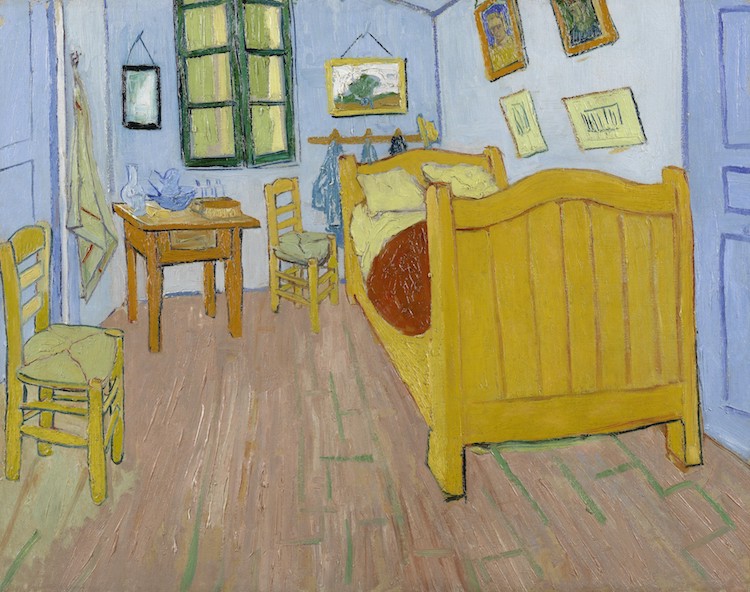
Other amazing options for an art-related field trip:
The Solomon R. Guggenheim Museum in New York, NY.
The Art Institute of Chicago in Chicago, Illinois.
The National Gallery of Art in Washington, DC. (One current virtual tour is Degas at the Opéra! Also check out Google Arts and Culture’s panoramic tour of the NGA.)
The Smithsonian’s National Portrait Gallery in Washington, DC. (In addition to the Google Arts and Culture tour, the NPS has designed a “Visit at Home” program.)
Always wanted to visit the Louvre? Open Culture has gathered three high-definition videos from Wanderlust Travel Videos so you can see Mona Lisa‘s smile, but also many lesser-known works.
Musée Dorsay in Paris, France.
Tate Modern in London, England – From the Bath of Psyche to 500 Years of British Art, you’ll have your pick of views.
The British Museum in London, England is huge and glorious. And exhausting. But they’ve developed 11 tips for exploring from home and you won’t have to jockey for a view of Rosetta Stone.
Is this feeling too highbrow for you? What about a Google street view of 12 Banksy murals?
Maybe you don’t even want to take a field trip to see the art, per se, but you just want to see art about the art? The Metropolitan Museum of Art in New York City has developed a map of the museum for the whole family. (Scroll down, then read the article at Atlas Obscura.)
Don’t feel like even thinking about where to click? Just want the experience to wash over you? How about this 5-hour, one-take journey through St. Petersburg, Russia’s Hermitage Museum. 45 galleries, 588 masterpieces. Sure, it’s basically an ad for Apple’s iPhone 11, but it’s worth the price of admission (which, of course, is free).
And if you don’t know where you’d like to take a field trip to see art, try the Art Camera. Pick just one piece of art (Manet’s The Conservatory? Frieda Kahlo’s Self-Portrait With Monkey? Rembrandt’s The Night Watch?) and get up-close and personal with just one painting, learning every brush stroke.
GET SOME PERSPECTIVE FROM YOUR COUCH
It’s easier for art museums to put their collections online. History museums and interactive exhibits are a little more complex. However, whatever fascinates you in this world likely has a museum. Try firing up your search engine and typing in the subject, the word museum, and “at home” or “virtual” to see what comes up.
The Smithsonian’s National Museum of African American History and Culture has video resource guide for exploring their archives available from home. This might be the perfect time to participate in the Community Curation Project, sort your photos, and find your family’s history in American history.
The Smithsonian’s National Museum of American History has over 100 online exhibits. They aren’t all ready-for-Prime-Time, but if history is your jam, field trips to the past will keep you busy for so long, you’ll forget that you’re sheltering in place while you’re traveling in time.
The National Women’s History Museum has a wide variety of exciting online exhibits on topics as wide-ranging as the women of NASA to women in Congress, from women who campaigned for suffrage and civil rights to women who waged World War II.
Things will get better, so consider signing for memberships with your local cultural venues. Time Travelers is a reciprocal membership network for historical museums and societies throughout the United States. Members of historical institutions can receive exclusive benefits and privileges at museums and historical sites nationwide, including free or reduced admission, gift shop discounts, free parking, and much more. Your local museums, zoos, and other venues likely offer similar reciprocal opportunities.
GRAB SOME LITERATURE WITH YOUR LATTE
Perhaps a poetry reading is more your style? Patrick Stewart has been reading Shakespearean sonnets, most in numerical order, each day. (He declared that #5 was “too hard.”) Here’s just one.
Sonnet 3#ASonnetADay pic.twitter.com/hI4GzH49P8
— Patrick Stewart (@SirPatStew) March 24, 2020
EVERYONE IS BEAUTIFUL AT THE BALLET (AND THE OPERA, TOO)
You already know about music streaming services like Spotify and Amazon Music, but what about visiting the opera or taking in some classical music?
The Metropolitan Opera is offering nightly streams of operas, as well as free streaming events for students.
London’s Royal Opera House has a massive YouTube playlist of the Royal Opera and the Royal Ballet. The sidebar includes affiliated groups, like the Welsh National Opera and the Scottish Opera.
The Berlin Philharmonic is presenting livestreams, though I’ve yet to find a translation option for English. But music is supposed to be a universal language!
AND MORE
As a professional organizer, I eschew clutter. As a curious person who fancies herself a completist, I like to collect ALL of the options.
And if nothing I have suggested piques your interest, the MCN (formerly the Museum Computer Network) had a mind-boggling list of hundreds of virtual museum resources to serve your needs: museum portals, art and cultural museums, museums of history and natural science, online exhibits, e-learning opportunities, and digital archives. Suddenly, it almost seems like quarantine won’t last long enough.
I know you probably wish you were out and about, but until we are all traveling freely about the planet, unmasked, take some time to give yourself some daily or weekly delights. Have some great field trips. Just skip the ones that only have an outhouse.
Paper Doll Interviews Melissa Gratias, Author of Seraphina Does Everything!
Today’s post is special – I’m introducing a new “friend of the blog.” Her name is Seraphina, and she’s the brainchild of my colleague, friend, accountability buddy, and Skyper-in-Crime, Melissa Gratias, Ph.D.

Melissa, known for her expertise helping busy professionals with their productivity, has authored a book about overwhelm and trying to juggle too many activities. And in a delightful twist, my girl Melissa has written this book for KIDS!
I was an early reader (and fan) of Seraphina, so when I found out that Seraphina Does Everything! was being released on April 9, 2019, I knew I wanted to spread the word to Paper Doll readers. This post is your chance to meet Melissa and Seraphina, and to avail yourself of a nifty bonus opportunity. (Stick around after the interview for important information about pre-sale orders and bonus bundles.)
Interview with Melissa Gratias
You and I met when you lived in Chattanooga and were starting your career as a professional organizer and productivity coach. But you’ve had a ZAM-POW-packed personal and professional life. Will you tell the Paper Doll readers how you got here?
Looney Tunes style…with Acme Rocket-Powered Roller Skates. Fortunately, things have gone better for me than for the coyote!
Part one of my life was academic: I received my master’s and doctoral degrees in psychology from Virginia Tech. I also enjoyed teaching at a university in Chattanooga.
Part two was corporate: I was a human resources specialist and eventually led several teams of people smarter than me.
Part three was entrepreneurial: I started my productivity consulting business in 2007 with some great advice from Paper Doll [Editor’s note: blush] and a lot of gumption. Since then, I have helped my clients through specialized productivity training, coaching, and consulting.
Part four is unfolding right now: Seraphina Does Everything! is an exciting project and has the potential to be a storybook series.
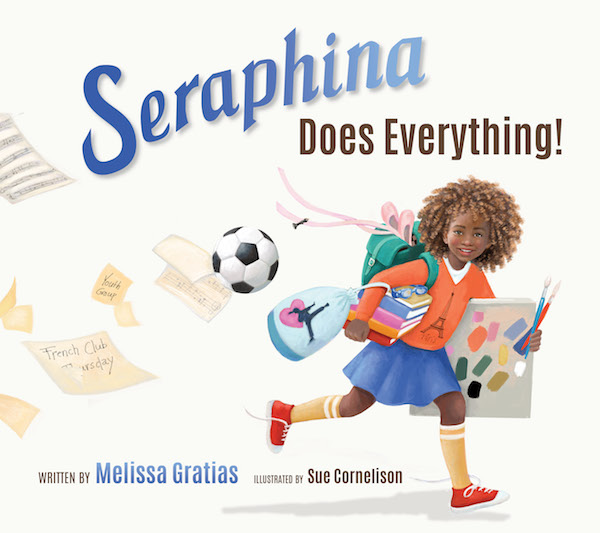
You have a lot of experience writing blog posts and ebooks for adults. How did you come to write a children’s book?
I started writing poems in fourth grade. I had a wonderful creative writing teacher, Mrs. Sapp, who I still remember fondly.
Then, I took a 30+ year break from writing poetry…well, except for that one about trees, graves, and deflated balloons that I wrote in the 9th grade. (I’d had a bad breakup.) [Editor’s note: We’ve all been there.]
During a speaking engagement in 2017, the president of a publishing company commented on my storytelling ability and asked if I would be interested in writing for kids. I was intrigued by his comment, went home, and wrote my first poem since elementary school. (The one with the dead tree doesn’t count).
My publisher, the National Center for Youth Issues (NCYI), has been producing storybooks since Mrs. Sapp told me I was a writer. I am writing stories for NCYI to help kids resolve the same issue that adults struggle with – how do we achieve balance?

The writing experience is different for every author. In the lingo of NaNoWriMo, there are plotters (people who outline and plan) and pantsers (those who write by the seat of their pants). What are you? How did Seraphina go from being an idea to a fully fleshed-out little girl with a life of her own?
I’m a dictator. Wait. That came out wrong.
I dictated the majority of Seraphina Does Everything! to my iPhone while sitting in the parking lot of the aquatic center where I live in Savannah, Georgia. My son is a competitive swimmer and I feel like I’ve spent a lifetime in that parking lot.
The story took several weeks to flesh out, and no, I’m not really an outliner. I could “see” the arc of the story in my head, but I wrote (spoke?) the story in no discernible order. Lots of verbiage ended up being cut, and at my publisher’s encouragement, I slip in and out of prose a few times in the book. I’m no Dr. Seuss, after all.
One fun aspect of writing Seraphina Does Everything! was naming my character. I searched baby name sites for hours. [Editor’s note: I neglected to ask if that raised Melissa’s husband’s eyebrows.] I wanted a name that reflected the energy of the amazing girl I’d grown to love. The name Seraphina means “fiery angel,” and that’s just what she is.
What aspect(s) of the book do you think will resonate the most with kids?
The kids who have read Seraphina Does Everything! love hearing Seraphina talk about her many activities. They get excited that Seraphina does some of the same things they like to do, including ballet, soccer, karate, art classes, and music lessons.
What’s interesting is to see them become a little pensive when Seraphina confesses to her dad that she is feeling sad. But my favorite part is when kids get a knowing smile on their face at the end of the book, just like Seraphina has. Kids are wiser than we sometimes give them credit for.
What’s in Seraphina Does Everything! for adults?
There are three words I hear most often from the teachers and parents who have read the book:
“I am Seraphina!”
Who doesn’t fall into the FOMO (Fear of Missing Out) trap from time-to-time? Many of us get overscheduled and overcommitted. We all must step back and re-evaluate our lives and work.
What is your favorite passage or section of the book?
I loved writing Dad’s responses to Seraphina’s dismay in the middle of the book. I could feel his affection and admiration for his daughter when she was crying in the back seat of the car.
Parents are demonized in the world too often. We are berated for both doing too much and not enough for our children. Most of us are just people who want the best for our kids. We want them to have options and opportunities. Seraphina’s dad is one of those people. He doesn’t drive her around to her activities for his own benefit. He loves his daughter. He wants her to have a good life. I relate to him.
The illustrations in Seraphina Does Everything! really make your great story pop off the page. What is your favorite illustration?
My publisher found the most amazing illustrator, Sue Cornelison. We selected her because of her ability to draw beautiful, diverse characters that communicate energy and emotion to the reader.
My favorite illustration is in the middle of the book when Seraphina is eating dinner in the back of the car. You see Seraphina’s thought-filled face on the left and the reflection of her face in the car window on the right. Behind the reflection is a girl in her driveway petting her dog. This image perfectly captures Seraphina’s internal struggle: Am I doing the things that really bring me joy?
Do you think there’s a stealth message for overextended parents in this book?
I’m hearing the theme song from Mission Impossible in my head right now…anyone else?
Yes, there is a message for us grown-ups, and it’s probably not very stealthy. After all, it is a storybook.
We all have busy seasons in our adult lives. It is easy to get carried away by our multiple commitments. If we are lucky, there will be someone to help us prioritize what’s important. And, like Seraphina, we can learn that “everything” isn’t something you do…it’s something you are.
[Editor’s note: The book also has tips for educators and parents, to help them guide children toward better balance and time management.]
How to Meet Seraphina
Seraphina Does Everything! is available in both softcover and hardcover. Grownups and tiny humans can read Seraphina and then create some breathing room for themselves in every day.
If you’d like a really special experience, you can also purchase the book directly from Melissa’s site. You’ll get an inscribed and signed copy of Seraphina, plus a not-available-anywhere-else essay by Melissa on how to teach life balance to children and teens.
Seraphina Does Everything! But you (and the tiny humans in your life) don’t have to do it all! Seraphina is a great role model for grownups and kids for prioritizing the best, and leaving aside the rest.
Organizing Your Writing for NaNoWriMo and More
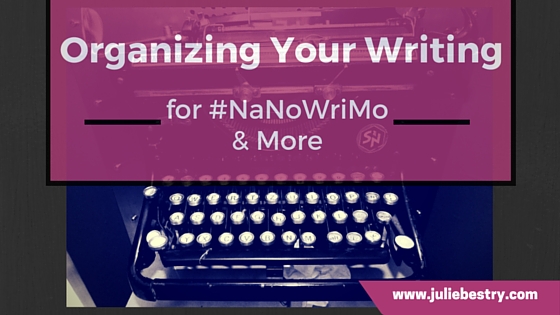
November is National Novel Writing Month, affectionately known as NaNoWriMo. This annual project/contest gives writers (and aspiring writers) the opportunity to be part of a collective push to focus creative energies on an endeavor they might otherwise put off until “someday” (a date notoriously absent from the calendar).
As the NaNoWriMo site explains, “On November 1, participants begin working towards the goal of writing a 50,000-word novel by 11:59 PM on November 30. Valuing enthusiasm, determination, and a deadline, NaNoWriMo is for anyone who has ever thought about writing a novel.” The official program includes social mechanisms for sharing your progress, and badges for participation, writing, and even “to celebrate the peaks and valleys of your personal creative journey.”
- National Novel Writing Month
- National Non-Fiction Writing Month
- National Academic Writing Month
Not a budding novelist? No problem. There are a few different November writing programs for non-fiction, including author/coach Nina Amir’s Write Nonfiction in November, called NaNonFiWriMo. It can be used to write one long non-fiction project, or, as she describes in this article for Writer’s Digest, you could also write 30 blog posts, essays or articles. If you’re a professor or an academic researcher who really needs to publish (and not perish), there’s Academic Writing Month, created by Dr. Charlotte Frost and run through PhD2Published.
The key element of NaNoWriMo and most of its sister programs is that it’s about eliminating all of the things that keep writers — the experienced and aspiring kinds — from actually writing: procrastination, self-criticism, and fear. The writing period in November is just that, for writing — there’s no editing. It’s just about putting your tush in the chair (or, I suppose, your feet in front of the standing desk).
The idea of organizing for a writing project may not seem like an apt comparison to typical organizing jobs. Usually, our goal is to take the chaos of a closet or a desktop and create order. We remove excess, sort the essentials, and group items so they are functional, accessible, and hopefully, somewhat aesthetically pleasing. Applying organizing principles to writing involves similar skills. Yes, the blank piece of paper (or blank screen) is daunting, but think of it as an already-cleared guest room or newly acquired shelving unit. You can clear all the clutter (of characters, plotlines, research, etc.) from your head, and start arranging them in ways that provide order.
This post will look at some strategies for organizing your research and planning resources, overcoming procrastination and writer’s block, and maintaining motivation.
CREATING YOUR ROAD MAP
NaNoWriMo has a variety of resources available for fiction writers, including the basics of getting started writing and ideas on the nuts and bolts of the fiction-writing process, covering characters and backstories, plot development and conflict, and setting and world-building. Academic Writing Month has a participant toolkit and an accountability spreadsheet.
Beyond planning to participate in a writing contest or program, you need to plan your writing. Saying you want to “write a book” or even a blog post, without preparation, has little more validity than deciding you want to be an astronaut. Think of it like going on a trip. Whether you use a gas station map or Grandpa’s hand-written directions or Siri’s intriguingly articulated GPS, you need guideposts to make sure you are on the right path. Depending on your writing project, you might start by creating documents to support your work:
Fiction
- character breakdown
- genealogy chart or Venn diagram of relationships between characters
- major plot points or events
- list of conflicts and their resolutions
- list of problems you’ve not yet figured out how to solve
Non-Fiction
- major concepts or themes
- sub-topics
- hypotheses to be tested or hypothetical questions needing answers
- brainstormed list of blog, article or chapter titles
- links or locations of digital or hard-copy references
Make sure this material is easily accessible to you in whatever format you like best. You might prefer to put together a three-ring notebook with dividers and pages for each resource element, so if you need to be mobile and write in different locations, your resources can go with you. If you’re visual and tactile, you might turn a wall, mirror or door into a planning board with Post-It Notes. (Use your digital device to snap a photo each day and keep that information accessible from anywhere.)
Prefer more tech? As someone who thinks linearly, I used Workflowy’s outline format to write 57 Secrets for Organizing Your Small Business. (Read more about Workflowy in the classic Paper Doll post, Don’t Be Listless…Be Listy (And Happy!) With Workflowy.)
Almost every lover of Evernote expounds on the possibilities of writing a book using Evernote. This recent blog post from Digital Inspiration shows how my beloved Trello‘s card system would work for writing a book. The web is full of recommendations for apps for planning and writing for NaNoWriMo:
5 Best Productivity Apps for NaNoWriMo
NaNoWriMo: The Best Writing Apps and Accessories for iPhone and iPad!
The Big Thread of Writers’ Mobile Apps
The Best Apps To Write, Plan & Plot Your NaNoWriMo Novel
Prepare for NaNoWriMo with Evernote
SETTING THE STAGE
Plan when you are going to write. Have you never, ever been able to go to a 6 a.m. exercise class? Don’t imagine you’ll be any more enticed to leave your warm bed to write. Think about when you are usually the most motivated, most creative, and most clear-thinking, and block time on the calendar as a fixed appointment each day as a firm commitment. Then consider a Plan B time period as a contingency for days when no matter how committed you are, emergencies force you to break your stride. Having a back-up in place means you won’t be tempted to argue with yourself or break the chain.
Do your Hokey Pokey. Assemble your resources before your appointed writing time. Need eleven sharpened Number 2 pencils? Require your coffee in your World’s Best Writer mug? Gotta shake yourself about? Great, but remember to schedule time to accomplish all of your pre-writing rituals so that nothing cuts into your writing time.
Save the environment. Personally, I can’t concentrate when I’m warm, but research shows that knowledge workers are half as productive when the thermostat is set at 68° as at 77°. Know what temperature works best for you.
Watch the ergonomics of your set-up, and avail yourself of the best task lighting so you aren’t dependent on ambient light. Reread my post 11 Ways To Organize Your Focus With Ambient Noise so you can minimize auditory distractions.
Create your theme song. Go through your music collection for songs that inspire you to greatness. Set an alarm to have your cell phone play a motivating anthem a few minutes before your posterior needs to be in the chair. Try the theme from Rocky, Rachel Platten’s Fight Song, Queen’s We Will Rock You, Jon Bon Jovi’s It’s My Life, or whatever puts you in an “I Can Do It” mode.
Make the world go away. Chances are good that you won’t have more than half an hour or an hour to dedicate to writing most days — your family and friends and telemarketers can wait. Close the door, set your instant messaging status to unavailable and set your phone to Do Not Disturb. (Just remember to reverse the process as the final ritual when you’re done writing for the day.)
Write. When the planned time arrives, grab your pen and your keyboard and start writing. Don’t wait for motivation.
OVERCOMING WRITER’S BLOCK
I wrote an entire chapter on conquering writer’s block in my book, but I have two favorite tips that always work for me, and my clients report that if they actually sit in the chair instead of making phone calls or surfing the net or doing other busy work, the words will come.
Write to an imaginary pen pal. Sometimes, you know too much about a topic to get a handle on where to start. Begin with “Dear Buddy/Pal/George Clooney, I am trying to write my [article, book, etc.]. It’s generally about [overarching idea]. I’m trying to bring together [list one to five major categories or concerns]. For example…” and then just free-write and talk about the subject. Don’t worry about grammar or fret about logical connections. Just concentrate on creating understanding. Because it’s not the monumental THING (the book, project, etc.) that’s at stake here, but merely telling a random someone about the thing, so that omnipresent fear of failure — what usually keeps our brains in a tizzy — dissipates. And remember, your word count in this email or letter counts towards your 50,000 words!
Do nothing. Seriously. A whole LOT of nothing. Set a timer for 30 minutes (or a 25-minute pomodoro, if that’s your style), and block all distracting stimuli. Face a blank pad or empty screen, but don’t write. You may have to sit on your hands, but do not, under any circumstances, write. You have no idea how slowly time passes when you’re staring at nothing, forbidden to create. Your thoughts may wander a bit, but by the end of the half-hour, your brain will be fairly bursting with ideas and you’ll be chomping at the bit to start writing. If your writing time is severely limited and this option would mean no word count for the day, you can reduce the “nothing” time by half, but the longer you have to sit, squirming, the more likely you’ll break through your block.
TRACKING YOUR PROGRESS
NaNoWriMo and related programs are more for the push to get something down on paper without the paralysis of self-analysis or editing, so the focus is on word count (and just doing it) more than anything else. Certainly, not all of your writing projects will be centered on quantity vs. quality, but there’s always something motivating about knowing where you stand in relationship to your goals.
Count your words. Almost all word processing programs have a word count generator. For example, Microsoft Word automatically counts the number of pages and words in your document and displays them on the status bar at the bottom of the workspace. If you put your cursor at the end of the page, it will show you how many words, total, you’ve written. If you put the cursor at any given point, it will tell you the word count from the beginning (of the document or section) to that point. As you type, the word count will increase; as you erase or self-edit, the word count will decrease. (But you’re supposed to be writing, not editing!)
If you put your cursor at the end of the page, it will show you how many words, total, you’ve written. If you put the cursor at any given point, it will tell you the word count from the beginning (of the document or section) to that point. As you type, the word count will increase; as you erase or self-edit, the word count will decrease. (But you’re supposed to be writing, not editing!)
If you prefer to just have a word count for a particular paragraph or section, highlight that section and right-click (on Mac, Control-Click) to get a word count for that portion only. If you prefer, you can insert the word count in your document. (For Mac, use Insert>Field>Document Information>NumWords.) Similarly, in Google Docs, select Word Count under the Tools menu.
Each type of word processing or writing program will have its own word count generator, so check your help menu. Of course, if you’re using a bare bones program or even a blank email page, you can always copy and paste what you’ve written into a free online word count program like Wordcounter or WordCountTool or WordCounterTool. Just be sure to copy (and not cut) your words, and aim to do your counts after you’ve already spent your allotted time on writing.
Track your word count. As with your choice of writing implement or resource format, how you track is less important than that you do track. Knowing what you’ve done helps motivate what you will do in the future.
Productivity genius Dave Seah created a free template for a downloadable NaNoWriMo Word Counting Calendar. (Dave also makes a 12-month word-counting calendar, so keep your eyes on his inspiring site.)
©2015 Dave Seah, Investigative Designer
Share your word count. Make it your Twitter name for the day. Post it as a Facebook status. Put it in the subject line or signature of your non-work emails.
MAINTAINING MOTIVATION
We tend to be good (sometimes, too good) at fulfilling our obligations to others but fall down on giving our own goals and needs the same respect. If outside pressure and validation motivates you, go with it. (This may not be the time to castigate yourself for how much you care about other people’s opinions.)
Get an accountability buddy. This may be another author, or it just might be a friend or colleague who is uplifting, supportive, and generally has a good sense of stick-to-it-ive-ness. Set an alarm (or ask your buddy to do so) to ensure a daily check-in via phone, text, or email to not only discuss successes, but also challenges. Brainstorm together how you can conquer difficulties.
I once spent days trying to solve a problem with a chapter I was writing. I called my colleague Deb Lee about an unrelated project, but mentioned the cognitive obstacle I was having in finding an angle for the chapter. I’m not sure Deb had a chance to exhale before I started spitting ideas at her, and by the end of the five-minute “conversation,” the problem was solved — without Deb ever getting to say a word. (She’s just THAT good!) Sometimes, when my brain is clogged, I just pull up her photo on the screen and the thoughts flow.
 Brandie Kajino, Deb Lee & moi at the NAPO Conference 2011, acting out social media platforms.
Brandie Kajino, Deb Lee & moi at the NAPO Conference 2011, acting out social media platforms.
Make a public commitment. Use social media to let your friends and colleagues know that you’re participating in NaNoWriMo or a similar writing project. Join the online forums and communities for your writing projects — a quick Googling should find the right group for your particular genre or field.
Most people will cheer you on and provide support. But, as with the Deb example above, sometimes it’s just the idea of someone that gives you what you need.
Use your down time (not your writing time) to embrace support. NaNoWriMo has official coaches tweeting inspiration from the NaNoWriMo Twitter account, and there’s even a recorded video of the prep webinar to give you a boost of motivation.
Post your WHY. Outside motivation is fine, but as with any organizing project, nothing can have lasting success unless the motivation comes from inside. Maybe you want fame and fortune. Perhaps you need publishing citations to ascend the professional ladder. Or it’s possible you just want to know you can do it. All of those reasons are good enough if they are YOUR reasons for doing it.
GOOD LUCK. GOOD WRITING!
50,000 words. That sounds like a lot. But 1666 words per day, or maybe a little more if you plan to skip Turkey Day? Well, obviously the Paper Doll blog is non-fiction, but as you may have noticed, my posts tend to run fairly long, and often far exceed that number. This ridiculously long post is 2500 words, and I wrote it in one sitting, counting research!
You can do it. Organize yourself for a fabulous month of writing!
NAPO 2015: Conference By the (Organizing) Books
Longtime readers of the Paper Doll blog know that the majority of the time, I’m writing about paper and information flow, and how to keep it all managed, but there’s one time each year where we go beyond to explore all sorts of organizing knowledge and innovations. Every year, just after the National Association of Professional Organizers’ Annual Conference and Organizing Expo, we spend weeks talking about the education and the products that can help organizers and clients (and you!) get and stay better organized and productive.
This year, I’m starting the series with something new about the NAPO conference experience. NAPO members have access to a variety of Special Interest Groups (SIGs), sub-groups that help NAPO members focus on their areas of concentration. SIG offerings support those who work with students and seniors, who specialize in relocations or small businesses, who speak and coach, who deal with technology and protect the environment, and more. Paper Doll is a member of the Authorship and Publishing SIG (led by my colleagues Debbie Lillard and Deb Cabral).
This year, as part of the NAPO EXPO, the Authorship and Publishing SIG ran a bookstore booth, carrying some of the industry’s best-loved books, authored by our own SIG members. This included newly released titles, classic organizing books, and recorded media and information products created by our members, whose number includes true celebrities of the organizing world, including Judith Kolberg and Barbara Hemphill. We even had a day and a half of fancy-schmancy book signings!
All of this was put together by organizing profession ROCK STAR authors Donna Smallin Kuper and Ramona Creel, who quickly, efficiently, and creatively constructed an outlet for organizing authors to spread the gospel (if you will) of organizing and productivity.
(That’s iconoclastic, straight-shooting Ramona at the left, Paper Doll in the center, and prolific writer and speaker Donna on the right. Trivia note: both Ramona and Donna are full-time RV-ers. Apparently genius preserves well in tin cans!)
If you’re reading this but were unable to attend NAPO 2015 and feel like you missed out, never fear — Paper Doll has you covered! I’ve listed each of the books and resources from our booth here, with links so you can check them out in depth, and perhaps make them part of your own personal library. Where possible, I’ve linked to Amazon paperback copies (because, well, I am your Paper Doll); you should be able to easily navigate to Kindle versions. (Please note that these are affiliate links and I will receive brownie points in the form of green pieces of paper if you purchase after clicking through this links.)
Home/Life Organizing Books
A Mom’s Guide to Home Organization by Debbie Lillard
DeClutter Your Life NOW! A Motivational Guide to Tackle All Aspects of Clutter in Your Life by Deborah Cabral
Make Room for Clarity by Rick Woods
How to Declutter and Make Money Now (2nd Ed, 2015) by Donna Smallin Kuper
50 Shades of Organizing…Your Life by Susan Unger and Lauri Mennel
Organize This! Practical Tips, Green Ideas, and Ruminations about your CRAP: Clutter That Robs Anyone of Pleasure by Vali Heist
Now What? A Simple Organizing Guide by Diane Quintana
(On the left is TV superstar Geralin Thomas; on the right is my longtime NAPO-Georgia friend and colleague and chronic disorganization specialist, Diane Quintana. They’re flanking the lovely and talented Valentina Sgro, author of the Patience Oaktree novels. Val wasn’t displaying her books, but she came out to support those of us who were!
Organizing Paper at Home: What to Toss and How to Find the Rest by Barbara Hemphill
The A-To-Z of Getting Organized: A Grown-Up Picture Book for the Chaotic and Cluttered by Ramona Creel
Life Cycle Organizing Books
Don’t Toss My Memories in the Trash – A Step-by-Step Guide to Helping Seniors Downsize, Organize and Move by Vickie Dellaquila
The Organized Bride’s Thank You Note Handbook: Let Systems and 101 Modern Sample Thank You Notes Take You from Overwhelmed to Organized by Stacey Agin Murray
Business Organizing Books
57 Secrets for Organizing Your Small Business by Julie Bestry (Hey, that’s Paper Doll!)
Don’t Agonize: Organize Your Office Now by Diane Hatcher
(The indefatigable Diane Hatcher has been keeping South Floridians on their toes since 1998!)
Professional Organizing Business Books and Resources
Before the Big O: Professional Organizers Talk about Life before Organizing by Regina Lark
Custom-Branded Clutter Flow Charts by Hazel Thornton
The Professional Organizer’s Bible: A Slightly Irreverent and Completely Unorthodox Guide for Turning Clutter into a Career by Ramona Creel
Student Organizing Books
What’s the Deal with Teens and Time Management by Leslie Josel
The Academic Planner: A Tool for Time Management by Leslie Josel
(The clever Leslie Josel is a fellow alumna of Cornell University. It’s obligatory that I note: GO BIG RED!)
Psychology Books
Psychic Debris, Crowded Closets: The Relationship Between the Stuff in Your Head and What’s Under Your Bed (2nd Ed., 2014) by Regina Lark
Chronic Disorganization and Hoarding Books
ADD-Friendly Ways to Organize Your Life by Judith Kolberg
Getting Organized in the Era of Endless by Judith Kolberg
Get Rid of Your Stuff Flash Cards by Judith Kolberg
From Hoarding to Hope by Geralin Thomas
Fresh Start: Overcoming Chronic Disorganization Group Manual by Karen Kruzan and Barbara Jo Dennison
Rise Above Your Stuff by Karen Kruzan and Barbara Jo Dennison (This title is new; check back often for an updated link.)
Inspirational Books
Less Clutter, More Life by Barbara Hemphill
Clear the Clutter, Find Happiness by Donna Smallin Kuper
For the Gifts We All Come Bearing by Jane Campbell
Time Management Resources
The Streamlined Time Solution by Miriam Ortiz y Pino
Until 2016…
I believe that the resurgence of a NAPO authors’ booth (we had one a decade ago, but it fell by the wayside) under the auspices of the Authorship and Publishing SIG is good for everyone. Professional organizers will be inspired by their colleagues to share their advice, which will, in turn, give the public more of an opportunity to see a wider variety organizing and productivity concepts and strategies presented by new voices and in different styles.
I’m inclined to believe that the authors of the above books — experts all, on productivity and organization — help bring that belief closer to reality.


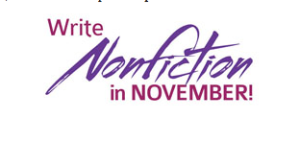
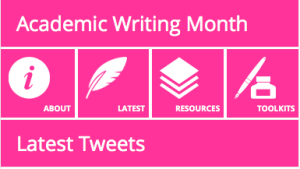
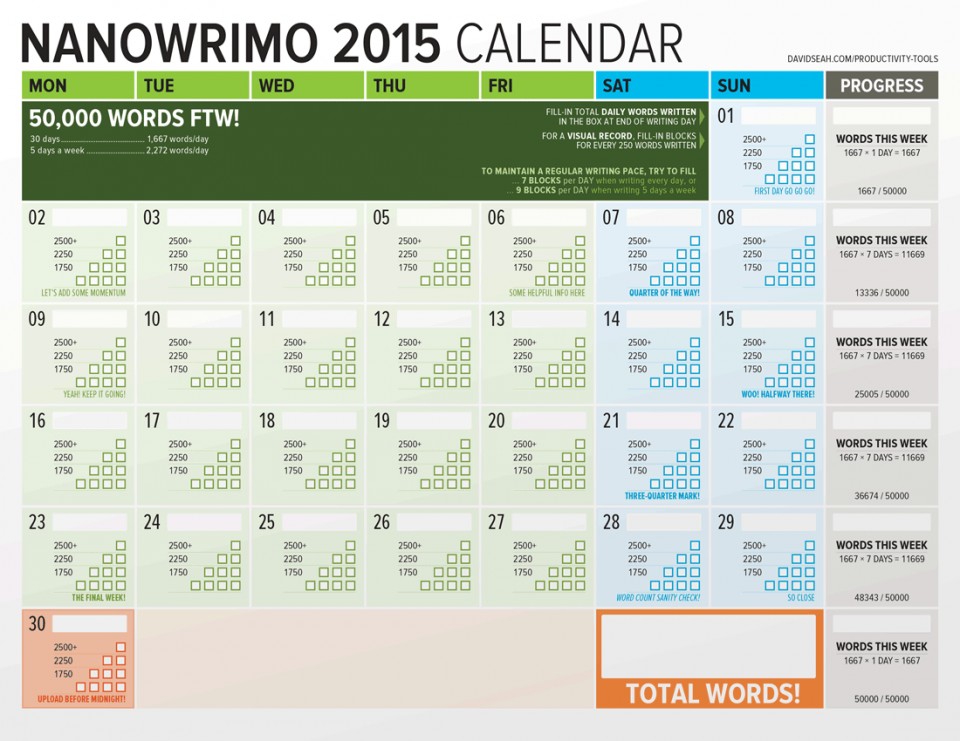

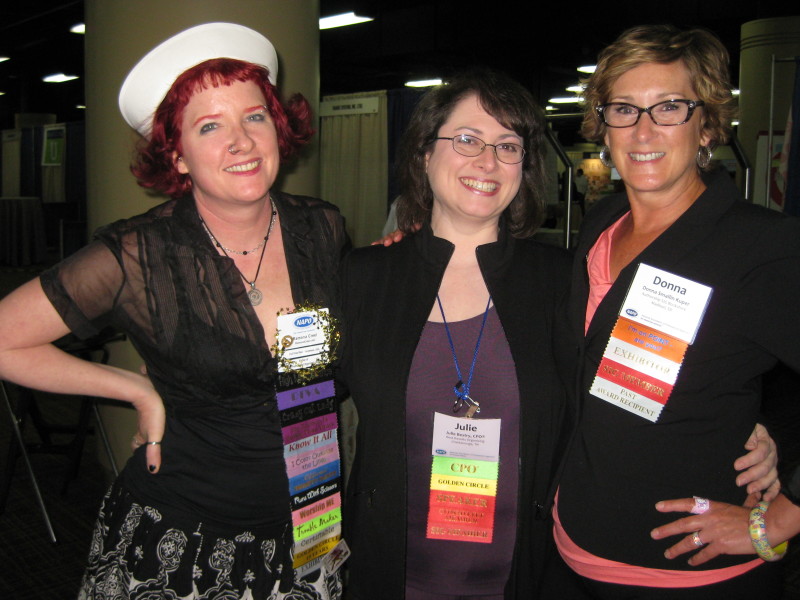

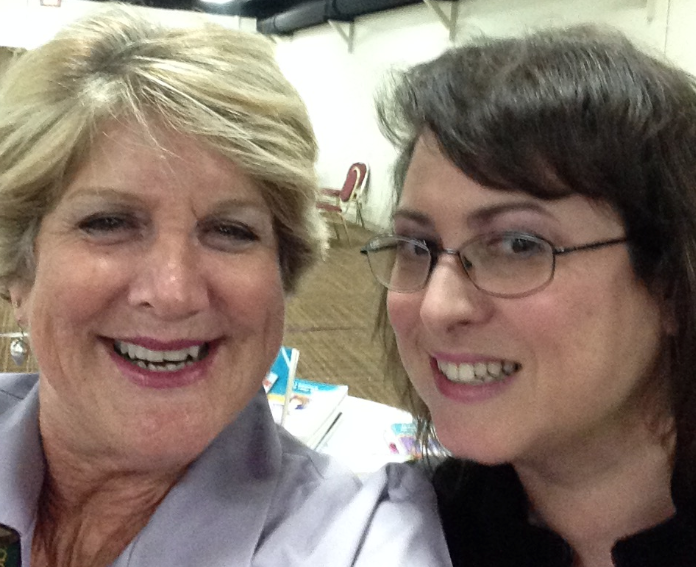
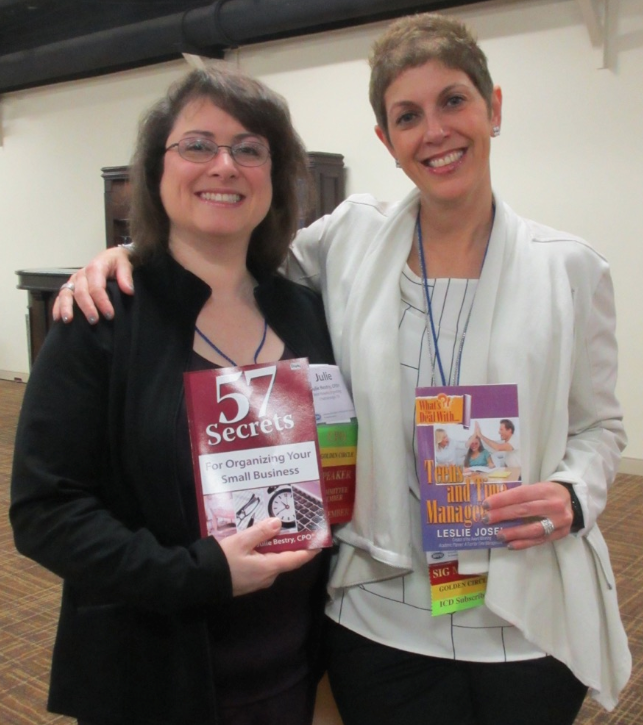



Follow Me